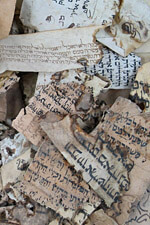The Taylor-Schechter Cairo Genizah Collection at Cambridge University Library is the world's largest and most important single collection of medieval Jewish manuscripts. For a thousand years, the Jewish community of Fustat (Old Cairo), placed their worn-out books and other writings in a storeroom (genizah) of the Ben Ezra Synagogue, and in 1896–97 the Cambridge scholar, Dr Solomon Schechter, with financial help from the Master of St John’s College, Charles Taylor, arrived to examine it. He received permission from the Jewish community of Egypt to take away what he liked (explaining later, ‘I liked it all’), and he brought 193,000 manuscripts back to Cambridge, where they form the Taylor-Schechter Cairo Genizah Collection.
The storeroom where the manuscripts were stored by the community of Fustat was a genizah, a sacred storeroom. According to rabbinic law (see, for instance, Mishna Shabbat 16:1), once a holy book can no longer be used (because it is too old, or because its text is no longer relevant) it cannot be destroyed or casually discarded: texts containing the name of God should be buried or, if burial is not possible, placed in a genizah.
At least from the early 11th century, the Jews of Fustat, one of the most important and richest Jewish communities of the Mediterranean world, reverently placed their old texts in the Genizah. Remarkably, however, they placed not only the expected religious works, such as Bibles, prayer books and compendia of Jewish law, but also what we would regard as secular works and everyday documents: shopping lists, marriage contracts, divorce deeds, pages from Arabic fables, works of Sufi and Shi'ite philosophy, medical books, magical amulets, business letters and accounts, and hundreds of letters: examples of practically every kind of written text produced by the Jewish communities of the Near East can now be found in the Genizah Collection, and it presents an unparalleled insight into the medieval Jewish world.
And see:










 Stumble It!
Stumble It!

No comments:
Post a Comment